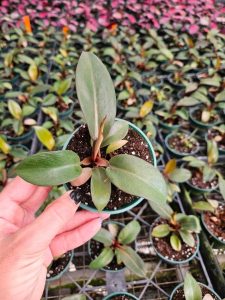Philodendron Black Cardinal

- Botainccal Name: Philodendron erubescens 'Black Cardinal'
- Fmaily Name: Araceae
- Stems: 3-4 inches
- Temperature: 18°C-27°C
- Other: Shade-loving, tolerates partial shade, not drought-resistant.
Overview
Product Description
The Philodendron Black Cardinal’s Alluring Charm
The Majestic Origins of the Black Cardinal
The Philodendron Black Cardinal, a cultivar of Philodendron erubescens, is a hybrid with a royal tropical heritage hailing from the rainforests of South America. Born in the 1980s in Florida from a cross between two species, it’s a testament to botanical artistry. This plant is known for its large, glossy leaves that start with a coppery-red hue and, as they mature, transition through deep green to a rich, dark purple-brown that’s almost black, offering a striking contrast to other houseplants.

Philodendron Black Cardinal
The Charm of Changing Hues
The foliage of the Philodendron Black Cardinal undergoes a fascinating color metamorphosis. Young leaves emerge with a burst of burgundy, maturing into a deep, dark green, and finally settling into a sophisticated dark purple-brown that’s nearly black, creating a dramatic and captivating display.
Cultivating the Perfect Environment
Philodendron Black Cardinal prefers a warm and humid environment, similar to its rainforest origins. It thrives in bright, indirect light and should be kept away from direct sunlight to prevent leaf scorch. This plant is not a fan of temperature swings and does well in stable conditions between 65°F to 78°F (18°C to 25°C).
A Popularity That Blooms
Highly sought after by plant enthusiasts, the Philodendron Black Cardinal is prized for its low-maintenance nature and striking foliage. It’s a favorite for those looking to add a touch of the exotic to their indoor spaces, with its dark, glossy leaves providing a contemporary and elegant contrast to other plants.
Finding the Right Spot
Perfect for rooms, balconies, and sunrooms, the Philodendron Black Cardinal can be a standalone specimen or a complementary addition to a collection of plants. Its compact growth habit makes it an excellent choice for smaller spaces or as a desktop feature. It can also be grown outdoors in zones 10 to 12 where it can tolerate more moderate temperatures.
The Philodendron Black Cardinal’s Origins
The Philodendron Black Cardinal, a cultivar of Philodendron erubescens, is a hybrid with a royal tropical heritage originating from the rainforests of South America. Born in the 1980s in Florida from a cross between two species, it’s a testament to botanical artistry. Known for its large, glossy leaves that start with a coppery-red hue and transition through deep green to a rich, dark purple-brown that’s almost black, offering a striking contrast to other houseplants.
The Allure of Evolving Colors
The foliage of the Philodendron Black Cardinal undergoes a fascinating color metamorphosis. Young leaves emerge with a burst of burgundy, maturing into a deep, dark green, and finally settling into a sophisticated dark purple-brown that’s nearly black, creating a dramatic and captivating display.
Crafting the Ideal Setting
Philodendron Black Cardinal prefers a warm and humid environment, similar to its rainforest origins. It thrives in bright, indirect light and should be kept away from direct sunlight to prevent leaf scorch. This plant is not a fan of temperature swings and does well in stable conditions between 65°F to 78°F.
A Popularity That Flourishes
Highly sought after by plant enthusiasts, the Philodendron Black Cardinal is prized for its low-maintenance nature and striking foliage. It’s a favorite for those looking to add a touch of the exotic to their indoor spaces, with its dark, glossy leaves providing a contemporary and elegant contrast to other plants.
Choosing the Perfect Place
Perfect for rooms, balconies, and sunrooms, the Philodendron Black Cardinal can be a standalone specimen or a complementary addition to a collection of plants. Its compact growth habit makes it an excellent choice for smaller spaces or as a desktop feature. It can also be grown outdoors in zones 10 to 12 where it can tolerate more moderate temperatures.










